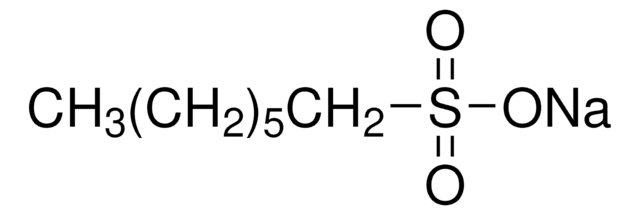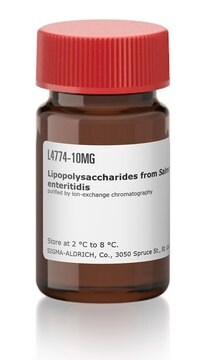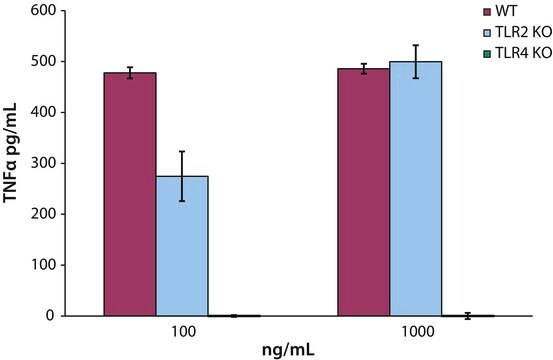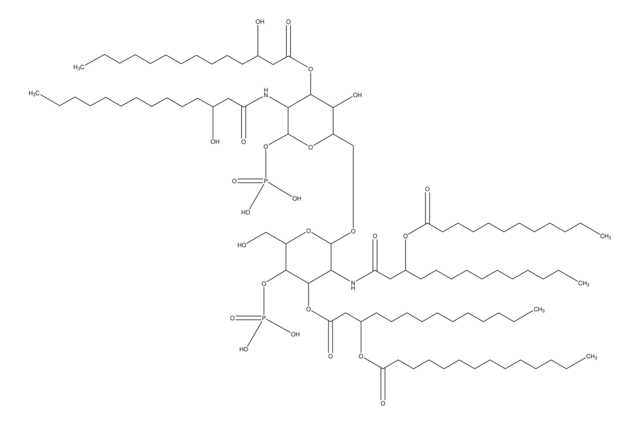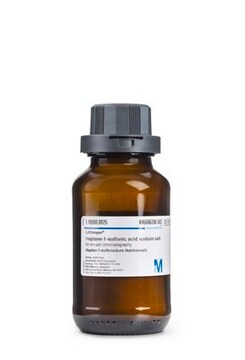L9764
Lipopolysaccharides (rough strains) from Salmonella enterica serotype minnesota Re 595 (Re mutant)
Synonym(s):
LPS
Sign Into View Organizational & Contract Pricing
All Photos(1)
About This Item
Recommended Products
biological source
Salmonella enterica (Serotype minnesota Re 595 mutant)
Quality Level
form
lyophilized powder
impurities
<3% Protein (Lowry)
color
white to yellow cast
solubility
water: 0.90-1.10 mg/mL, hazy to turbid, colorless to faintly yellow
shipped in
ambient
storage temp.
2-8°C
Looking for similar products? Visit Product Comparison Guide
General description
This product is prepared from Salmonella Minnesota strain Re 595 (Re mutant) using a phenol-chloroform-petroleum ether extraction procedure. The source strain is ATCC 49284. A unique structure in the LPS of strain Re 595 was shown to induce secretion and aggregation in human platelets.
Application
- Charge and aggregation pattern govern the interaction of plasticins with LPS monolayers mimicking the external leaflet of the outer membrane of Gram-negative bacteria: This study examines how charge and aggregation patterns affect the interaction of plasticins with lipopolysaccharides (LPS) from rough strains like Salmonella enterica serotype Minnesota Re 595. The findings contribute to understanding the molecular interactions involved in microbial resistance mechanisms (Michel et al., 2015).
Biochem/physiol Actions
Lipopolysaccharides (LPS) are localized in the outer layer of the membrane and are, in noncapsulated strains, exposed on the cell surface. They contribute to the integrity of the outer membrane, and protect the cell against the action of bile salts and lipophilic antibiotics.
Preparation Note
Prepared by phenol-chloroform-petroleum ether extraction.
The product is soluble in water (5 mg/ml) or cell culture medium (1 mg/ml) yielding a hazy, faint yellow solution. A more concentrated, though still hazy, solution (20 mg/ml) has been achieved in aqueous saline after vortexing and warming to 70-80 oC. Lipopolysaccharides are molecules that form micelles in every solvent. Hazy solutions are observed in water and phosphate buffered saline. Organic solvents do not give clearer solutions. Methanol yields a turbid suspension with floaters, while water yields a homogeneously hazy solution.
The product is soluble in water (5 mg/ml) or cell culture medium (1 mg/ml) yielding a hazy, faint yellow solution. A more concentrated, though still hazy, solution (20 mg/ml) has been achieved in aqueous saline after vortexing and warming to 70-80 oC. Lipopolysaccharides are molecules that form micelles in every solvent. Hazy solutions are observed in water and phosphate buffered saline. Organic solvents do not give clearer solutions. Methanol yields a turbid suspension with floaters, while water yields a homogeneously hazy solution.
Other Notes
To gain a comprehensive understanding of our extensive range of Lipopolysaccharides for your research, we encourage you to visit our Carbohydrates Category page.
related product
Product No.
Description
Pricing
Signal Word
Warning
Hazard Statements
Precautionary Statements
Hazard Classifications
Acute Tox. 4 Oral
Storage Class Code
11 - Combustible Solids
WGK
WGK 3
Flash Point(F)
Not applicable
Flash Point(C)
Not applicable
Personal Protective Equipment
dust mask type N95 (US), Eyeshields, Gloves
Choose from one of the most recent versions:
Already Own This Product?
Find documentation for the products that you have recently purchased in the Document Library.
Customers Also Viewed
S Kumar et al.
Parasite immunology, 34(7), 372-382 (2012-04-11)
Studies have shown that glycosylphosphatidylinositols (GPIs) of Plasmodium falciparum activate macrophages mainly through Toll-like receptor 2 (TLR2)-mediated signalling and to certain extent through TLR4-mediated signalling to induce proinflammatory cytokine production. However, the ability of parasite GPIs to activate dendritic cells
Ahsan F Malik et al.
Proceedings of the National Academy of Sciences of the United States of America, 108(50), 20095-20100 (2011-11-24)
Implantation of biomaterials and devices into soft tissues leads to the development of the foreign body response (FBR), which can interfere with implant function and eventually lead to failure. The FBR consists of overlapping acute and persistent inflammatory phases coupled
Emmanuelle Kuhn et al.
American journal of physiology. Endocrinology and metabolism, 306(1), E75-E90 (2013-11-14)
The mineralocorticoid receptor (MR) exerts proadipogenic and antithermogenic effects in vitro, yet its in vivo metabolic impact remains elusive. Wild type (WT) and transgenic (Tg) mice overexpressing human MR were subjected to standard chow (SC) or high-fat diet (HFD) for
Xianzhu Wu et al.
Journal of immunology (Baltimore, Md. : 1950), 184(8), 4338-4348 (2010-03-17)
Dendritic cells (DCs) play a crucial role in the development of protective immunity to malaria. However, it remains unclear how malaria parasites trigger immune responses in DCs. In this study, we purified merozoites, food vacuoles, and parasite membrane fragments released
Anna E Karagianni et al.
Veterinary immunology and immunopathology, 155(4), 219-228 (2013-08-28)
Alveolar macrophages (AMs) constitute the first line of defence in the lung of all species, playing a crucial role in the regulation of immune responses to inhaled pathogens. A detailed understanding of the function and phenotype of AMs is a
Our team of scientists has experience in all areas of research including Life Science, Material Science, Chemical Synthesis, Chromatography, Analytical and many others.
Contact Technical Service
